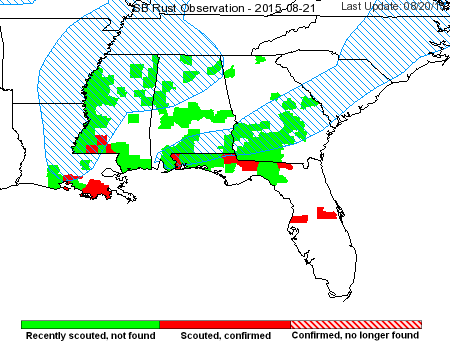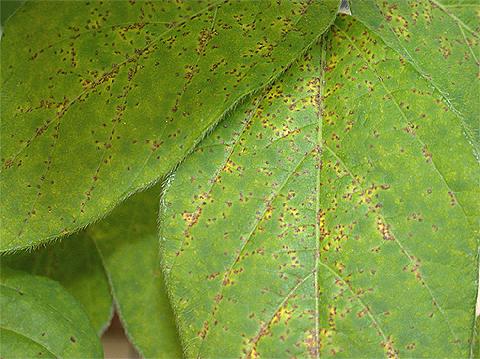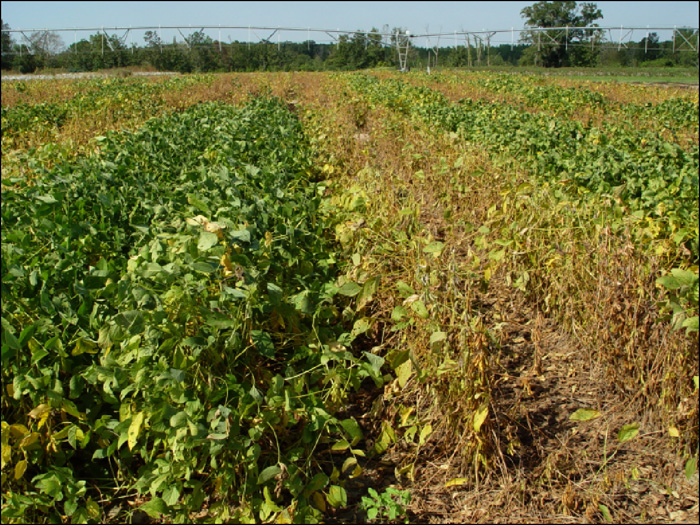
Source: Soybean Rust IPM PIPE
Soybean rust (SBR) has been found on the sentinel plot in Jackson County at the Extension Office. Because these plots are scouted for SBR on a regular basis, the SBR was confirmed very early. SBR has now been confirmed in Florida, Louisiana, Mississippi and Texas in 2015.
Soybean growers should consider a fungicide application, if weather conditions stay as they are. Slightly cooler weather favors the spread of SBR, but it likes high humidity and rain showers.
Scouting for Soybean Rust

Brown-red lesions caused by Phakopsora pachyrhizi on the upper soybean leaf surface. Photo courtesy of U. S. Department of Agriculture
The first symptoms of soybean rust caused by Phakopsora pachyrhizi begin as very small brown or brick-red spots on leaves (Figure 2). Symptoms caused by P. meibomiae are similar to those of P. pachyrhizi, but this lesson will focus on P. pachyrhizi because most of the research and observations have been made with this species. In the field, these spots usually begin in the lower canopy at or after flowering, although seedlings can be infected under certain circumstances. Often the first lesions appear toward the base of the leaflet near the petiole and leaf veins. This part of the leaflet probably retains dew longer, making conditions more favorable for infection. Lesions remain small (2-5 mm in diameter), but increase in number as the disease progresses.
American Phytopathological Society
More details on scouting for the disease are available in the publication Asian Soybean Rust
Fungicide Options for SBR

Soybeans infected and not infected with Asian soybean rust, caused by Phakopsora pachyrhizi, in a fungicide trial in Attapulgus, GA, 2006. Photo by R. C. Kemerait, Jr.
Dr. Kemerait, UGA Extension pathologist, shared the photo above from a fungicide trial he conducted on soybean rust back in 2006. With heavy disease pressure, fungicide treatment is dramatic. For the past eight years, SBR has not been a major problem in the Southeast, but conditions have been more favorable this year for disease development. I recommend using a triazole, if soybean rust is already present in a field. If it is not present, use a strobilurin (Headline, Stratego, etc.) to control a wider variety of diseases. Spray if you find rust in your soybeans, or when soybeans start into the reproductive stage (R1 to R3). Below are Dr. Kemerait’s bottom-line management tips for soybean rust.
Kemerait’s Asian soybean rust management tips:
- Asian soybean rust can (and does) limit yields in some soybean fields in Georgia most
years. - Asian soybean rust has occurred in every county in the state at some time or another over
the past 10 years. Soybean rust is most likely to be found on soybeans and kudzu. - Soybean producers are advised to protect their crop with a fungicide IF a) the crop has
reached reproductive growth, b) Asian soybean rust has been detected locally or is likely
to be found locally, c) environmental conditions are favorable for development and
spread of rust, e.g. adequate rainfall or storms, and d) the grower’s crop has the potential
to make a satisfactory crop. - Asian soybean rust is less likely to be a problem in a field with poor growth and plants
stunted by drought or other factor than in a field with good growth, heavy foliage, and a
closed canopy of foliage. - Some growers plan to apply fungicides to their soybean crop automatically as the crop
reaches the R3/pod formation growth stage. They reason that since they will already be
applying Dimilin and boron during this time period and because the crop is susceptible to
rust, it just makes sense to tank-mix the fungicide for good timing and to save a trip
across the field later. This is a good strategy, especially when other diseases may occur
during this time as well. However, if soybean rust does not develop until much later, the
R3 fungicide application may not have been needed. - In some studies, a single, well-timed application of an effective fungicide may be all that
is needed to adequately protect a grower’s crop from soybean rust. However, depending
upon the timing of arrival of the soybean rust pathogen (earlier versus later) and the
impact of weather, e.g. tropical storms, it may be necessary (and profitable) to make a
second fungicide application 2-4 weeks after the first application.
To get all of Dr. Kemeraits recommendations for soybean disease control, download:
2015 Georgia Soybean Disease Guide
- History of Conservation Tillage and Cover Crop Use in Florida - January 7, 2022
- 2021 Florida Peanut Crop Starting Strong - June 18, 2021
- Progress of Carinata Research in the Panhandle - January 29, 2021
